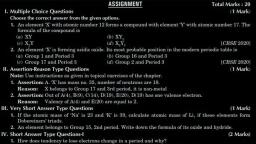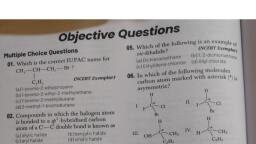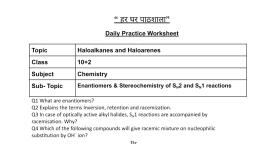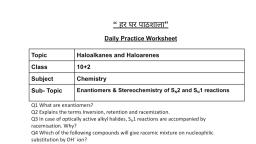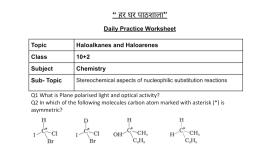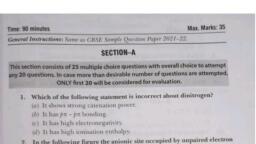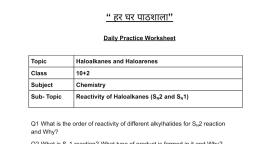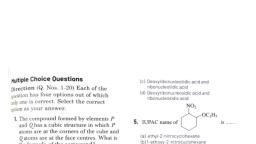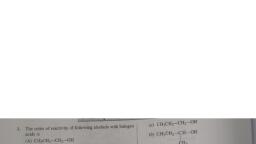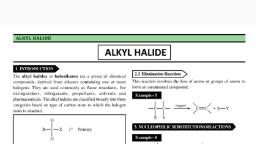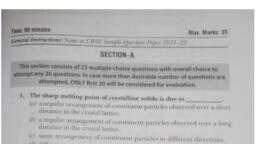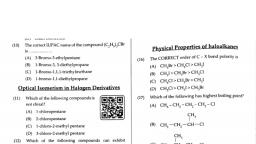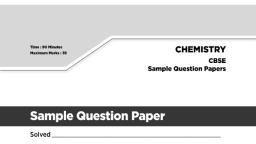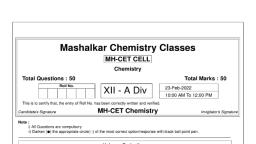Page 2 :
9., , Arrange the following compounds, , biling ,points, , in increasing order of their boiling, , elNCERT, , CH, CHCH-CH,Br (i) CH,CH,CH,CH,Br (ii) H,C-C-CH,, , 0, , CHs, , Br, (a) (i), 10., , <, , ), , <, , Chlorobenzene is, , ), , (6) ()< (i)< (ii), , (ii), , formed, , by, , attacks the, , reagent will you, , CH,CH,CH,CH,, , use, , -, , for the, , The, , reagents, , B, , 13., , (NCERT EseWhimplWa, (NCERT Exemplar, , () [AICLr, , following reaction?, , CH,CH, CH, CH, CI, , +, , CH,CH,CHCICH,, , (6) NaCl + H,SO,, , (d) Cla, , for the, , <, , resence of(i)<, AlCI,, , () AICl, , (a) Cl,/UV light, () Cl gas in dark, 12., , (d) (Gii), , benzene in the presen, benzene ring in this reaction?, , (a) C, , Which, , Gii) < ()< (i), , reaction of chlorine with, , ofthe following species(0) CI*, 11., , ba, , gas in the presence of iron in dar, , following conversion is/are, , Br, , H--H, , luloodemnrosa gutollo, , (a) Zn/CH,OH, , 6alcoholic, ), KOH followed by NaNH, , c)aqueous KOH followed by NaNH, , d), , The order of reactivity of following alcohols with, , alcoholic KOHj sbirolda senbi, , halogen acids is, , T10Hol sn 0311oo n NCERT Exem, , CH3, (A) CH-CH,-CH,OH, , (B) CH, CH,-CH-OH, , nerdde, , CH,, , )(B) > (A) > (C), , 6) (C)> (B) > (A), , (a) (A) > (B) > (C), , (C) CH,CH,-c-OH, , CH,, , (d) (A) > (C) > (B), , 14. In which of the following molecules carbon atom marked with asterisk () is asymmetric?, , [NCERT Exemplar, , C, , Br, , CHs, , OH, , Br, , CHslalobnuitouil, CaHs, (io), , ii), (a) ), (i), ii), (Gro), 15., , Which of the, , () (), cii), (v), , 6) (). i), (i), , following structures, , d) Ö, (), (), , is enantiomeric with the molecule (A), , given below:, , NCERT Exemplon, , GH3, , H,C, , Q, , Br, (A), , (a), , (6), , H, , CHs, , Br, C, , B-C, , H,C, 16., , Two, , possible, , Br, , (), , CaHs, , Br, stereo-structure, , (a) mesomers, , 84 | Chemistry-XIl: Term-1, , H,C, , CgH5, , of CHy-CH(OH)COOH which, , (6) enantiomers, , are, , C) diastereomers, , HC, , H, lled, , optically active are, (d) atropsomers
Page 3 :
Alkylhalides, halides, 7, , retention, , undergoing nucleophilic bimolecular substitution, , of configuration, , 18., , involvedma pd, , (6) racemic mixture, , (a), inversion ofconfiguration, , d) formation of carbocation, halides, following, will, alkyl, ich of the, undergo Syl reaction most readily? [NCERT Exemplar, Wh, (6) (CH),C--CI, )(CH),C-Br, (d) (CH,),CI, , (a) ( C H ) , C F, , e the following ()I , i) C, (i) Br, the increasing order of nucleophilicity would be, For, , 19., , (a), , (6) Br°<C<1°, , 1<Br°<CI°, , ) CI<Br°<1, , (d) 1<CI9<Br°, , uene reacts with a halogen in the presence of iron (III) chloride giving ortho and para halo, Toluen, 20., , compounds., , The reaction, , (a) Electrophilic, ., , c), , (6) Electrophilic substitution reaction, (d) Nucleophilic substitution reaction, , Among the following compounds, which one will have a zero dipole moment?, , (a) 1,, ), , 1-Dichloro, , ethylene, , ethane, , ), , None of these compounds l l, , will have least hindered rotation about carbon-carbon, , (6) ethylene, , bond?, , (d) hexachloroethane, , C) acetylene, , configurational isomers of a bromo compound C5H,Br, the addition of HBr to pent-2-yne respectively aresoldaoolaib, , The number, (a) I, , and, , of structural and, , (a), , angle, , formed, , by, , 2 and I, , be about, 1, 1, 2, 2-tetrachloroethene and tetrachloromethane will, (d), 109-5°, and, 120, c) 109-5° and 90°, (b) 90° and 109-5°, , in, , 120° and 109:5°, , bond, 25. The C-H, , (d), , ut-(C) 4 and 2, , () 2 and 4, , 2, , Cl-C-Cl, 24. The, , Pg-t, , in, , longest, (6) CH, , distance is, , (a) C,H, , d) CH Brgu, , (C) CgHg, , of toluene in presence of sunlight, 26. Chlorination, , and heat and followed, , by treatment with aqueous, , ooibeiue sdlgoals, , NaOH givesoiu, , (6) p-cresol, , (a) o-Cresol, , (d) benzoic acid, , () 2, 4-dihydroxytoluene, , 27., , b, , 6) cis-1, 2-Dichloroethylene, , trans-1, 2-dichloroethylene, , Which of the following, (a), , 93,, , [NCERT Exemplar), , addition reaction, Free radical, , 21., , a0, , is, , elimination reaction, , alcoholic, 1-chlorobutane on reaction with, , potash gives, , d) butan-2-ol, , (c) but-2-ene, , (6) butan-1l-ol, , () but-1-ene, , first, in the absence of peroxides, the, 28. In the addition of HBr to propene, (b) Br, , )H, , (a) H, , addition of, step involves the, , ardb o on d) Br, it, , gtotnn, , peroxide, gives, )n-propyl chloride, )no reaction, , in presence of benzoyl, 29. When HCI gas is treated with propene, , () 2-chloropropane, , (6) allyl chloride, , 30. Geometrical isomerism is shown by, , (b) CH,CH, , (a) CH, = C (Br)I, ., , Toluene, , reacts, , =, , (Br)I, , C, , =, , C, , (Br)I (d) CH,CH, , to give, with chlorine in presence of sunlight, )p-chlorotoluene, (6) benzoyl chloride, , (a) benzyl chloride, 4., , ) (CH3)2 C, , The compound which reacts with HBr, , obeying, , CCl, , (d) o-chlorotoluene, , Markownikov's rule is, )trans-but-2-ene, , (6) cis-but-2-ene, , (a) CH,= CH, , =, , d) (CH) C= CH, , 33. Dilver benzoate reacts with bromine to give, , (a) CH6, 34., , (6) CH,C0OBr, involved in the formation, , esilverreaction, fluoride, , (c) m-Br-CgH,COOAg () CGH,Br, from methyl bromide in, of fluoromethane, , presence of, , is called, , Wurtz reaction, () Sandmeyer reaction(d), (6), of peroxide is, of HCl to propene in presence, addition, the, during, , (a) Swarts reaction, termediate, , (a) CH,CHCH, Cl, , Finkelstein reaction, , (6) CH,CHCH,, , (e) CH,CH,CH,, , (d) CH,CH,CH, , Haloalkanes and Haloarenes, , 85
Page 7 :
Which, , wing, , followin, , ofthe, , CH,C1,, , are, , CH,Br, CH,F, , arranged in the decreasing order of dipole moment?, () CH,CI, CH,F, CH,Br, (d) CH,Br, CH,F, CH,CI, , F, CH,CI, CH,, , (a), CH,Br,, , c), , f the following reaction involves both aryl and alkyl halide?, , Whichofthe, , (a), , (6) Wurtz fittig reaction, (d) Friecdal-Crafts reaction, , Wurtz reaction, , ( ) Sandmeyer reaction, , f the follo, following compounds is not formed when a mixture of methyl bromide and ethyl, , ofthe, Which, , treated, , is, ( a ), , sodium metal in the presence of dry ether?, , witl, , (6) ethane, , b r o m i d, , n, d, 79. C-CIb, on, d, , in, , of chlorobenzene, , comparison, , to, , C-CI bond in, , (a), , and stronger, Shorter, , (), , llowing undergoes nucleophilic, , follo, ofthe, , Which, , (6) Ethyl chloride, , (a) BenzylChloride, , 80., , be, by reacting, reagent may, 6) Diethyl ether, made, , A, , Grignard, , 82., , Th, , conversion, , alkyl, , drohalogenation, , )An, reaction, , 83., , 4, , ,oP1, , reaction, can, , be used to, , Fitting, (a) Toluene, , end product (¢), , onotiegad, , following, , sOCl, , ), alc. KOHB, , 7ffl, , (a), , 20H, KN(6), (alc.), , (c))o i n, +, (d) CaH,NH,, , )CH,CO,H, , HCOOH, , CH,CH,NH,, , CH,CHCH,CI-, , above, In the, (a) Propane, , 86., , [CBSE 2020 (56/5/1)1, , (d) Chlorobenzene, , (0) Dipheny, , CH,CONH2, , 85., , classified as, , by aqueous NaOH is, , sequence:ngira, , is the, , C H5 OHyridine, Pyridine, (a), , d) Exhyl alcohol, , )Ethyl iodide, , prepare, , (b) Acetophenone, , Identify the, , (d) Isopropyl chloríde, , 6) A substitution reaction, reaction, d) A dehydration, , reaction, , mechanism?, , exclusively by Sl, , (c) Chlorobenzene, , halide into an alcohol, , (a) A dehydro, , addition, , substitution, , magnesium with, , (a) M e t h y l a m i n e, , of an, , methyl chloride is, , 6) Shorter and weaker, (d) Longer and stronger, , weaker, , and, Longer, , 81., , (d) methane, , )propane, , b u t a n e, , reaction,, , the, , product D is, , (b) 2,, , 3-Dimethylbutane (c), , HBr, , >, , pzodoib-l,loereod, , D, , C, , o ) Allyl, , Hexane, , bromide, , A; A' is, , CH-CH=CH-CH3+, , CHs, Br, (a), , CH-C-CH-CHlad, , g, , oluo lee s, , (d), , CH, hich, , ofthe following, room, , concentrated, , HCl at, , BrCH-CH-CH-CHs, , CHs, , CH-CH-CH-CH,Br, , alcohols, , lite, , CH-CH-CH-CHs, , Br CH, , RRO, , CH, ), , (0), , will, , yield, , temperaturer, , the corresponding, (b), , alkyl, , chloride, , on, , reaction with, , CH,CH-CH-OH, , CHs, , (a) CH,CH,-CH,-OH, , CHs, (d), , C) CH,CH-CH-CH,OH, , CH, , CH,CH-C-OH1, , CH, Haloalkanes, , and Haloarenes, , 89
Page 8 :
Identify the compound, , 88., , reaction., Y in the following, , N,CI, , NgNaNO,+ HC, 273-278K, , Cu,Cl,, , Y +, , Nal, , CI, , C, 89., , Which of the, , (a), , following, , halogen exchange, , reaction?, , RI+ NaX, , RX+ Nal, , (6)-, , is, , HX, , )R-OH + HXndl, , CH2, , RX+ H,O, , CH, , Fe, , +A2dark, , CH, , 90. Which reagent will you use for the following reaction?, , CH, CH, CH, CH,, (a) Cl/UV light, , CH,CH, CH,CH,CI +CH,CH, CHCICH,, 6) NaCl + H,SO,, , (C) Cl, gas in dark, 91., , udorbedsbL, bsb, , (d) Clo gas, , of-Brin, Theposition, the compound CH,CH, (a) Allyl, , =, , in the, , presence of iron in dark., , CHC (Br)(CH,), can be, , 6) Aryl, )Vinyl, 92. A primary alkyl halide would prefer to undergo, (a) Syl reaction, (6) S2 reaction, C)a-Elimination, , classifiedas, , d) Secondary, , (d) Racemisation, , 93. The correct IUPAC name for diethyl bromomethane is, , (a) 1-Bromo-1,1-diethoxyethane, (c) 1-Bromo-1-ethylpropane, , (6) 3-Bromopentane, , d) 1-Bromopentanesy9udiearta, , 94. Reaction of C,H,CH,Br with aqueous sodium hydroxide follows, (a) Syl mechanism, , 30=)-H3, , (6) Sy2 mechanism, , (c) Any of the above two depending upon the temperature of reaction, (d) Saytzeff rule, , 95. Which of the carbon atoms present in the molecule given below are asymmetric?, , HO, , OHH, H, , H, , )a, d, , (6) b, c, , (a) a, b, c, d, , OH, , (d) a, b, c, , 96. Which of the following compounds will give racemic mixture on nucleophilic substitutouby, OH ion?, , Br, i) CH-CH-Br, , (i) CH-C-CH,, , CHs, a) (), , 90| Chemistry-Xl: Term-1, , (i) CH-CH-CH,Br, , CHs, , C,Hs, (6) ), (i), (i), , C) i), (ii), , d) (). (ii)
Page 11 :
121., , convert chlorobenzene, to, (a) NaNO/HCl and dil HC, phenol, the, NaOH and, , In orde, ler, , reagents, 6) NaOH needed, o, n, conversion ofof an alkyl halides, t (d) conc. and dil HCl, , H,Ou, , ), , 122., , to, , into, , la), , A, , Answers, (), , 2. (a), , . (6), , 9. ), 17. (), , 10. (6), , 11. (a), , 18. (d), , 25. (C), , 26. (d), , 19. (), 27. (a), , 33. (d), , 34. (a), , 41(d), , 42. (c), , (d), , 50. (d), , 57. (d), , 58. (c), , 65. (), 73. c), , 66. (a), , S1., 89., , (c), (a), , 97., 105. a), 113. (), 191, , (h), , an, , alcohol by, , dehydrohalogenation reaction, , c) An addition reaction, , 49., , are, , The conversion, , (a), 82. (6), , 35. (6), 43. (a), 51. (), 59. (a), 67. (6), 75. (a), , l, d, , 4., , H,sO,, , and, , H,O, aqueous NaOH is, classified as, , Substitution reaction CBSE 2020 (56/5/1)1, )A, A, , i, (6), , 12.(6), , dehydration reactionr, , 5.(c), 13. (6), , .(b), 28.(a), , 21.(c), , 36.(a), , 37.(d), 45.(a), 53.(d), 61.(C), 69.(d), , 44. (d), 52.d), 60. (6), , 68.(d), 76. (b), , 29.0, , 77.(6), 85.(b), , 6.), 14.(6), 22.(a), 30. (6), , 38.(a), , 7. (6), , 15.(0), 23.(6), 31.(), , 114. (d), 129, , (h), , 115. (6), , 108. (d), 116. (6), , 109. (a), , 117.(a), , n, 8. (a), , 16.(b), 24. (a), , 32.(, , 46. (d), , 39.(c), 47.(d), , 54.(C), , 48.), , 55. (6), , 56. C), , 63.(), 71.(6), 79.(C), 87. (d), , 64. (6), , 62.(d), , 70. ), , on78.(d), (), 84., 90. (a), 86. (a), 91., (a)o 92. (b)ot 93.(6)itr94., (a)l95.(b), 98. (a)o99. (d), 100., (c)), 102., 101.d)s, (a)oin 103. (6), 106. (6), 107. (c), 83. (c), , o, uM so e, , 40.(, , 72.(6), 80.(), 88. (a), , 96.(), , 110. (a), , 111. (6), , 104. (a), 112. (c), , 118. (6), , 119. (d), , 139, (c)

